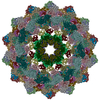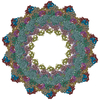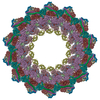+ Open data
Open data
- Basic information
Basic information
| Entry |  | |||||||||
|---|---|---|---|---|---|---|---|---|---|---|
| Title | AcMNPV apical cap - C2 plug only - focused map 1 | |||||||||
 Map data Map data | AcMNPV apical cap - C2 plug body 1 | |||||||||
 Sample Sample |
| |||||||||
 Keywords Keywords | nucleocapsid / VIRUS | |||||||||
| Biological species |  Autographa californica nucleopolyhedrovirus Autographa californica nucleopolyhedrovirus | |||||||||
| Method | single particle reconstruction / cryo EM / Resolution: 6.1 Å | |||||||||
 Authors Authors | Effantin G / Kandiah E / Pelosse M | |||||||||
| Funding support | 1 items
| |||||||||
 Citation Citation |  Journal: Nat Commun / Year: 2025 Journal: Nat Commun / Year: 2025Title: Structure of AcMNPV nucleocapsid reveals DNA portal organization and packaging apparatus of circular dsDNA baculovirus. Authors: Gregory Effantin / Eaazhisai Kandiah / Martin Pelosse /  Abstract: Baculoviruses are large DNA viruses found in nature propagating amongst insects and lepidoptera in particular. They have been studied for decades and are nowadays considered as invaluable ...Baculoviruses are large DNA viruses found in nature propagating amongst insects and lepidoptera in particular. They have been studied for decades and are nowadays considered as invaluable biotechnology tools used as biopesticides, recombinant expression systems or delivery vehicle for gene therapy. However, little is known about the baculovirus nucleocapsid assembly at a molecular level. Here, we solve the whole structure of the Autographa californica multiple nucleopolyhedrovirus (AcMNPV) nucleocapsid by applying cryo-electron microscopy (CryoEM) combined with de novo modelling and Alphafold predictions. Our structure completes prior observations and elucidates the intricate architecture of the apical cap, unravelling the organization of a DNA portal featuring intriguing symmetry mismatches between its core and vertex. The core, closing the capsid at the apex, holds two DNA helices of the viral genome tethered to Ac54 proteins. Different symmetry components at the apical cap and basal structure are constituted of the same building block, made of Ac101/Ac144, proving the versatility of this modular pair. The crown forming the portal vertex displays a C21 symmetry and contains, amongst others, the motor-like protein Ac66. Our findings support the viral portal to be involved in DNA packaging, probably in conjunction with other parts of a larger DNA packaging apparatus. | |||||||||
| History |
|
- Structure visualization
Structure visualization
| Supplemental images |
|---|
- Downloads & links
Downloads & links
-EMDB archive
| Map data |  emd_51806.map.gz emd_51806.map.gz | 74.8 MB |  EMDB map data format EMDB map data format | |
|---|---|---|---|---|
| Header (meta data) |  emd-51806-v30.xml emd-51806-v30.xml emd-51806.xml emd-51806.xml | 14.5 KB 14.5 KB | Display Display |  EMDB header EMDB header |
| FSC (resolution estimation) |  emd_51806_fsc.xml emd_51806_fsc.xml | 10.7 KB | Display |  FSC data file FSC data file |
| Images |  emd_51806.png emd_51806.png | 27.3 KB | ||
| Masks |  emd_51806_msk_1.map emd_51806_msk_1.map | 103 MB |  Mask map Mask map | |
| Filedesc metadata |  emd-51806.cif.gz emd-51806.cif.gz | 3.8 KB | ||
| Others |  emd_51806_half_map_1.map.gz emd_51806_half_map_1.map.gz emd_51806_half_map_2.map.gz emd_51806_half_map_2.map.gz | 75.1 MB 75.1 MB | ||
| Archive directory |  http://ftp.pdbj.org/pub/emdb/structures/EMD-51806 http://ftp.pdbj.org/pub/emdb/structures/EMD-51806 ftp://ftp.pdbj.org/pub/emdb/structures/EMD-51806 ftp://ftp.pdbj.org/pub/emdb/structures/EMD-51806 | HTTPS FTP |
-Validation report
| Summary document |  emd_51806_validation.pdf.gz emd_51806_validation.pdf.gz | 1 MB | Display |  EMDB validaton report EMDB validaton report |
|---|---|---|---|---|
| Full document |  emd_51806_full_validation.pdf.gz emd_51806_full_validation.pdf.gz | 1 MB | Display | |
| Data in XML |  emd_51806_validation.xml.gz emd_51806_validation.xml.gz | 17.6 KB | Display | |
| Data in CIF |  emd_51806_validation.cif.gz emd_51806_validation.cif.gz | 23.3 KB | Display | |
| Arichive directory |  https://ftp.pdbj.org/pub/emdb/validation_reports/EMD-51806 https://ftp.pdbj.org/pub/emdb/validation_reports/EMD-51806 ftp://ftp.pdbj.org/pub/emdb/validation_reports/EMD-51806 ftp://ftp.pdbj.org/pub/emdb/validation_reports/EMD-51806 | HTTPS FTP |
-Related structure data
- Links
Links
| EMDB pages |  EMDB (EBI/PDBe) / EMDB (EBI/PDBe) /  EMDataResource EMDataResource |
|---|
- Map
Map
| File |  Download / File: emd_51806.map.gz / Format: CCP4 / Size: 103 MB / Type: IMAGE STORED AS FLOATING POINT NUMBER (4 BYTES) Download / File: emd_51806.map.gz / Format: CCP4 / Size: 103 MB / Type: IMAGE STORED AS FLOATING POINT NUMBER (4 BYTES) | ||||||||||||||||||||||||||||||||||||
|---|---|---|---|---|---|---|---|---|---|---|---|---|---|---|---|---|---|---|---|---|---|---|---|---|---|---|---|---|---|---|---|---|---|---|---|---|---|
| Annotation | AcMNPV apical cap - C2 plug body 1 | ||||||||||||||||||||||||||||||||||||
| Projections & slices | Image control
Images are generated by Spider. | ||||||||||||||||||||||||||||||||||||
| Voxel size | X=Y=Z: 1.35 Å | ||||||||||||||||||||||||||||||||||||
| Density |
| ||||||||||||||||||||||||||||||||||||
| Symmetry | Space group: 1 | ||||||||||||||||||||||||||||||||||||
| Details | EMDB XML:
|
-Supplemental data
-Mask #1
| File |  emd_51806_msk_1.map emd_51806_msk_1.map | ||||||||||||
|---|---|---|---|---|---|---|---|---|---|---|---|---|---|
| Projections & Slices |
| ||||||||||||
| Density Histograms |
-Half map: AcMNPV apical cap - C2 plug body 1 - half map 2
| File | emd_51806_half_map_1.map | ||||||||||||
|---|---|---|---|---|---|---|---|---|---|---|---|---|---|
| Annotation | AcMNPV apical cap - C2 plug body 1 - half map 2 | ||||||||||||
| Projections & Slices |
| ||||||||||||
| Density Histograms |
-Half map: AcMNPV apical cap - C2 plug body 1 - half map 1
| File | emd_51806_half_map_2.map | ||||||||||||
|---|---|---|---|---|---|---|---|---|---|---|---|---|---|
| Annotation | AcMNPV apical cap - C2 plug body 1 - half map 1 | ||||||||||||
| Projections & Slices |
| ||||||||||||
| Density Histograms |
- Sample components
Sample components
-Entire : Autographa californica nucleopolyhedrovirus
| Entire | Name:  Autographa californica nucleopolyhedrovirus Autographa californica nucleopolyhedrovirus |
|---|---|
| Components |
|
-Supramolecule #1: Autographa californica nucleopolyhedrovirus
| Supramolecule | Name: Autographa californica nucleopolyhedrovirus / type: virus / ID: 1 / Parent: 0 / Macromolecule list: #1-#15 / NCBI-ID: 46015 Sci species name: Autographa californica nucleopolyhedrovirus Virus type: VIRION / Virus isolate: STRAIN / Virus enveloped: Yes / Virus empty: No |
|---|
-Experimental details
-Structure determination
| Method | cryo EM |
|---|---|
 Processing Processing | single particle reconstruction |
| Aggregation state | particle |
- Sample preparation
Sample preparation
| Buffer | pH: 7 |
|---|---|
| Vitrification | Cryogen name: ETHANE |
- Electron microscopy
Electron microscopy
| Microscope | TFS KRIOS |
|---|---|
| Image recording | Film or detector model: GATAN K3 BIOQUANTUM (6k x 4k) / Average electron dose: 30.0 e/Å2 |
| Electron beam | Acceleration voltage: 300 kV / Electron source:  FIELD EMISSION GUN FIELD EMISSION GUN |
| Electron optics | Illumination mode: FLOOD BEAM / Imaging mode: BRIGHT FIELD / Nominal defocus max: 2.5 µm / Nominal defocus min: 1.0 µm |
| Experimental equipment |  Model: Titan Krios / Image courtesy: FEI Company |
 Movie
Movie Controller
Controller





















 Z (Sec.)
Z (Sec.) Y (Row.)
Y (Row.) X (Col.)
X (Col.)













































